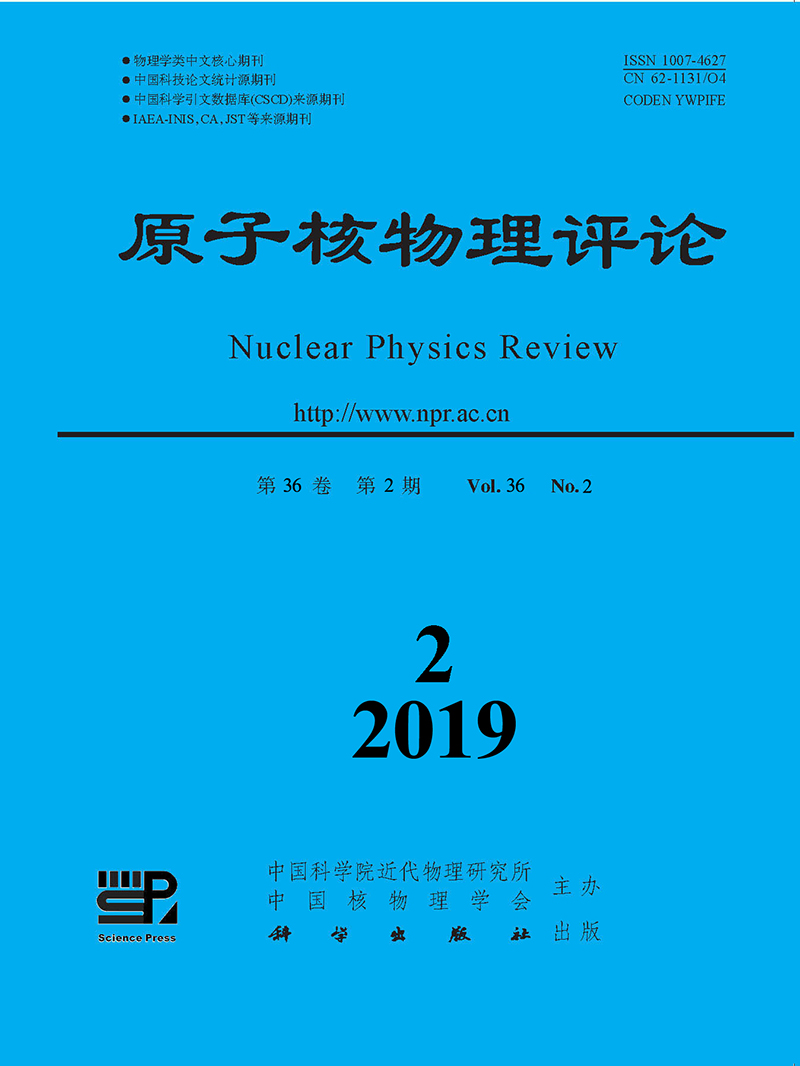|
[1]
|
NEYENS G. Rep Prog Phys, 2003, 66:633. |
|
[2]
|
TANIHATA I, KOBAYASHI T, YAMAKAWA O, et al. Phys Lett B, 1988, 206:592. |
|
[3]
|
FRICKE G, HEILIG K. Nuclear Charge Radii[M]. Heidelberg:Springer-Verlag, 2004:385. |
|
[4]
|
YANG X F, COLLAPS and CRIS collaboration. J Phys Conf Ser, 2018, 1024:012031. |
|
[5]
|
FRANBERG H, DELAHAYE P, BILLOWES J, et al. Nucl Instr and Meth B, 2008, 266:4502. |
|
[6]
|
PAPUGA J, BISSELL M L, KREIM K, et al. Phys Rev Lett, 2013, 110:172503. |
|
[7]
|
LU Z T, MUELLER P, DRAKE G W F, et al. Rev Mod Phys, 2013, 85:1383. |
|
[8]
|
GARCIA RUIZ R F, BISSELL M L, BLAUM K, et al. Phys Rev C, 2015, 91:041304. |
|
[9]
|
YANG X F, Wraith C, Xie L, et al. Phys Rev Lett, 2016, 116:182502. |
|
[10]
|
BAI S W, YANG X F. Nuclear Physics Review, 2018, 35:382. (in Chinese) (白世伟, 杨晓菲. 原子核物理评论, 2018, 35:382.) |
|
[11]
|
DE GROOTE R P, BILLOWES J, BINNERSLEY C L, et al. Phys Rev C, 2017, 96:041302. |
|
[12]
|
NEUGART R, BILLOWES J, BISSELL M L, et al. J Phys G:Nucl Part Phys, 2017, 44:064002. |
|
[13]
|
DICKER A R, CAMPBELL P, CHEAL B, et al. Hyperfine Interact, 2014, 227:139. |
|
[14]
|
MINAMISONO K, MANTICA P F, KLOSE A, et al. Nucl Instr and Meth A, 2013, 709:85. |
|
[15]
|
VOSS A, PROCTER T J, SHELBAYA O, et al. Nucl Instr and Meth A, 2016, 811:57. |
|
[16]
|
FEDOSSEEV V, CHRYSALIDIS K, DAY GOODACRE T, et al. J Phys G:Nucl Part Phys, 2017, 44:084006. |
|
[17]
|
FEDOSSEEV V N, KUDRYAVTSEV YU, MISHIN V I. Phys Scr, 2012, 85:058104. |
|
[18]
|
FEDOSSEEV V N, FEDOROV D V, HORN R, et al. Nucl Instr and Meth B, 2003, 204:353. |
|
[19]
|
COCOLIOS T E. Hyperfine Interact, 2017, 238:16. |
|
[20]
|
MARSH B A, DAY GOODACRE T, SELS S, et al. Nat Phys, 2018, 14:1163. |
|
[21]
|
COCOLIOS T E, ANDREYEV A N, BASTIN B, et al. Phys Rev Lett, 2009, 103:102501. |
|
[22]
|
FERRER R, BREE N, COCOLIOS T E, et al. Phys lett B, 2014, 728:191. |
|
[23]
|
HIRAYAMA Y, MUKAI M, WATANABE Y X, et al. Phys Rev C, 2017, 96:014307. |
|
[24]
|
BACKE H, EBERHARDT K, FELDMANN R, et al. Nucl Instr and Meth B, 1997, 126:406. |
|
[25]
|
FERRER R, BARZAKH A, BASTIN B, et al. Nat Commun, 2017, 8:14520. |
|
[26]
|
ZADVORNAYA A, CREEMERS P, DOCKX K, et al. Phys Rev X, 2018, 8:041008. |
|
[27]
|
SANCHEZ R, NORTERSHAUSER W, EWALD G, et al. Phys Rev Lett, 2006, 96:033002. |
|
[28]
|
NORTERSHAUSER W, TIEDEMANN D, ZAKOVA M, et al. Phys Rev Lett, 2009, 102:062503. |
|
[29]
|
FLANAGAN K T, VINGERHOETS P, AVOGULEA M, et al. Phys Rev Lett, 2009, 103:142501. |
|
[30]
|
GARCIA RUIZ R F, BISSELL M L, BLAUM K, et al. Nat Phys, 2016, 12:594. |
|
[31]
|
WRAITH C, YANG X F, XIE L, et al. Phys Lett B, 2017, 771:385. |
|
[32]
|
YANG X F, TSUNODA Y, BABCOCK C, et al. Phys Rev C, 2018, 97:044324. |
|
[33]
|
NEYENS G, KOWALSKA M, YORDANOV D, et al. Phys Rev Lett, 2005, 94:022501. |
|
[34]
|
YORDANOV D T, BISSELL M L, BLAUM K, et al. Phys Rev Lett, 2012, 108:042504. |
|
[35]
|
GARCIA RUIZ R F, GORGES C, BISSELL M, et al. J Phys G:Nucl Part Phys, 2017, 44:044003. |
|
[36]
|
DE GROOTE R P, BILLOWES J, BINNERSLEY C L, et al. Phys Rev C, 2017, 96:041302. |
|
[37]
|
LYNCH K M, BILLOWES J, BISSELL M L, et al. Phys Rev X, 2014, 4:011055. |
|
[38]
|
DE GROOTE R P, BUDINČEVIĆ I, BILLOWES J, et al. Phys Rev lett, 2015, 115:132501. |
|
[39]
|
GARCIA RUIZ R F, VERNON A R, BINNERSLEY C L, et al. Phys Rev X, 2018, 8:041005. |
|
[40]
|
LYNCH K M, WILKINS S G, BILLOWES J, et al. Phys Rev C, 2018, 97:024309. |
|
[41]
|
BEHR J A, GWINNER G. J Phys G:Nucl Part Phys, 2009, 36:033101. |
|
[42]
|
WANG L B, MUELLER P, BAILEY K, et al. Phys Rev Lett, 2004, 93:142501. |
|
[43]
|
MUELLER P, SULAI I A, VILLARI A C C, et al. Phys Rev Lett, 2007, 99:252501. |
|
[44]
|
PARKER R H, DIETRICH M R, KALITA M R, et al. Phys Rev Lett, 2015, 114:233002. |
|
[45]
|
JIANG W, BAILEY K, LU Z-T, et al. Geochim Cosmochim Acta, 2012, 91:1. |
|
[46]
|
XIA X W, LIM Y, ZHAO P W, et al. Atom Data Nucl Data Tables, 2018, 121:1. |
|
[47]
|
WADA M, TAKAMINE A, OKADA K, et al. AIP Conf Proc, 2009, 1120:109. |
|
[48]
|
YANG X F, TAKESHI F, TAKASHI W, et al. Phys Rev A, 2014, 90:052516. |
|
[49]
|
LIU W P, BAI X X, ZHOU S H, et al. Phys Rev Lett, 1996, 77:611. |
|
[50]
|
SUN Z, ZHAN W L, GUO Z Y, et al. Nucl Instr and Meth A, 2003, 503:496. |
|
[51]
|
ZHOU X H. Nuclear Physics Review, 2018, 35:339. |
|
[52]
|
XIAO G Q, XU H S, WANG S C. Nuclear Physics Review, 2017, 34:275. (in Chinese). (肖国青, 徐瑚珊, 王思成. 原子核物理评论, 2017, 34:275.) |
|
[53]
|
YE Y L. EPJ Web Conf, 2018, 178:01005. |






 甘公网安备 62010202000723号
甘公网安备 62010202000723号 DownLoad:
DownLoad: